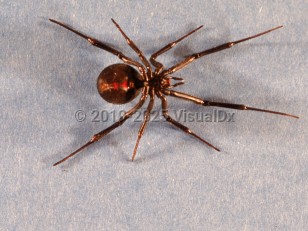In the United States, the American Association of Poison Control Centers at 800-222-1222 is available 24 hours a day to connect callers directly to their region's poison center. They are also available online.
Prehospital treatment includes the following:
- ABCs (Airway, Breathing, Circulation)
- Intermittent ice application for analgesia
Hospital treatment includes the following:
- Continued ABC monitoring
- Routine cleansing of bite site
- Intermittent application of ice
- Tetanus prophylaxis
- For severe pain and muscle spasms – intravenous (IV) narcotics and benzodiazepines
- For hypertension unresponsive to narcotics and benzodiazepines – IV nitroprusside or nifedipine
Diagnosis Overview:
The widow spiders (Latrodectus species) are found on every continent except Antarctica and represent over 31 species. They live outdoors in dark areas or indoors in undisturbed spaces (eg, garages, wood sheds), where they wait for insects to become entrapped in their prototypical irregularly constructed web. Widow spiders are most abundant and active during the warm months but can often be seen inside during cooler weather. Latrodectus spp are naturally nonaggressive and usually only bite if touched or trapped in clothing. Of these 31 species, all of which are highly venomous, the North American female black widow (L mactans) and its Australian sister, the red back spider (L hasselti), garner most of the attention with the prominent red marking on their abdomens, often resembling an hourglass.
Widow spider venoms are all very similar and contain a neurotoxic component called alpha-latrotoxin. This toxin inserts itself into calcium channels in the presynaptic neuron creating a Ca2+ pore leading to neurotransmitter release. The specific synaptic cleft involved dictates the neurotransmitter released; however, all neurotransmitters can be affected. Massive release of acetylcholine and catecholamines into the central nervous system are theorized to produce the specific clinical symptoms of envenomation. The result is initial stimulation of neuromuscular transmissions followed by depletion of synaptic vesicles. Local tissue changes are minimal as the venom lacks locally active toxins capable of producing inflammation.
A bite from a widow spider is typically severe, painful, and often described as "burning." If not immediate, symptoms can be expected within 60 minutes of the bite. Tiny fang marks with a local inflammatory reaction may be evident, and so most envenomated patients are aware they were bitten by some type of spider or insect. Local toxicity is classically manifested through a triad of diaphoresis, local pain, and piloerection with a concomitant target lesion. Most of the time symptoms do not progress beyond this local reaction. However, with significant envenomation, a wide range of systemic symptoms can be observed.
Systemic symptoms include myalgias, fever, hypertension and tachycardia, vomiting, tremor, and paresthesia. Muscle spasms can be seen in the chest, legs, and back, and patients classically exhibit abdominal rigidity. Less commonly, altered mental status, myocarditis, elevated troponin levels, leukocytosis, and rhabdomyolysis can be a sequalae of alpha-latrotoxin toxicity.
Symptoms usually resolve over a 3- to 7-day period, and deaths are exceedingly rare.



